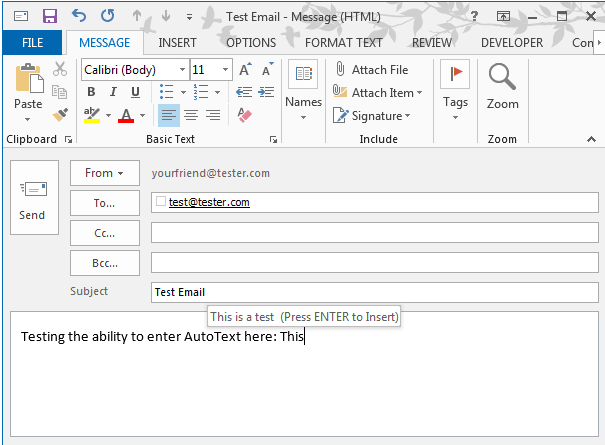- Find the “model text” that you want to use as the AutoText entry and copy it into your Windows clipboard (CTRL+C) (this could be a frequent paragraph or short phrase that you type often in numerous responses. Draft a new email and paste it into the body of the new email. Format it and clean it up to the format you want it in (bullets, numbered, paragraphs, etc). We suggest removing any client names to make it generic.
- Select the text and then select Insert > Quick Parts > AutoText > Save Selection to AutoText to AutoText Gallery

- Give it a name (nickname) with at least 4 characters.
- To use the AutoText entry, simply place your cursor in the body of the email (in the desired location), and then type the first 4 characters of the AutoText name. You will see a pop-up preview of your entry. If you want to insert it, simply hit your Enter key. Another way to insert it is to select Insert > Quick Parts > AutoText > and then select the AutoText entry from the preview gallery.

New Resources In Your Inbox
Get our latest cybersecurity resources, content, tips and trends.

Other resources that might be of interest to you.
AI Shields & Cybersecurity Potions for October Cyber Threats
October is the spookiest time of year for your tech team, and not just because of Halloween. October is also Cybersecurity Awareness Month, and more often than not, businesses are not cybersecurity aware. Cybersecurity Awareness Month is the perfect ti
Vivian Lee
>>Read More
7 Security Operations Center (SOC) Tools for Advanced Security
Ransomware attacks have tripled since 2020. The average incident now costs businesses $1.85 million, and that number keeps climbing. And while 60% of companies run security operations centers (SOCs), most are flying blind with fragmented tools and silo
Jesse Sumrak
>>Read More
Customer Success Story: Blue Water
Personalized IT Support Helps Blue Water Serve Vacationers Blue Water is a real estate development company headquartered in Ocean City, Maryland. The company specializes in hospitality and outdoor recreation. The campgrounds that Blue Water run delight
Conor Quinlan
>>Read More
